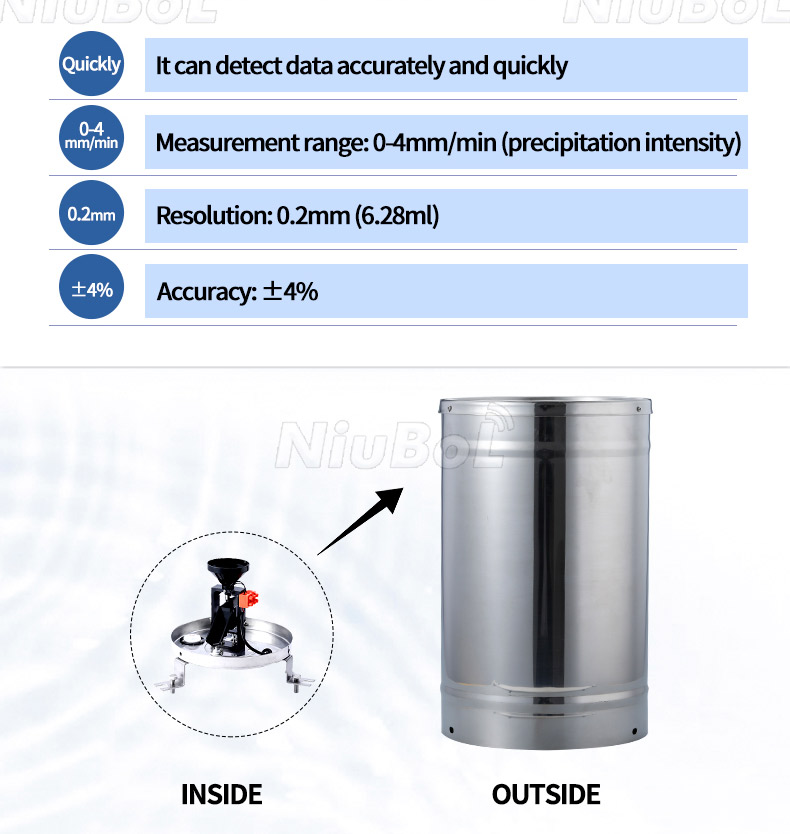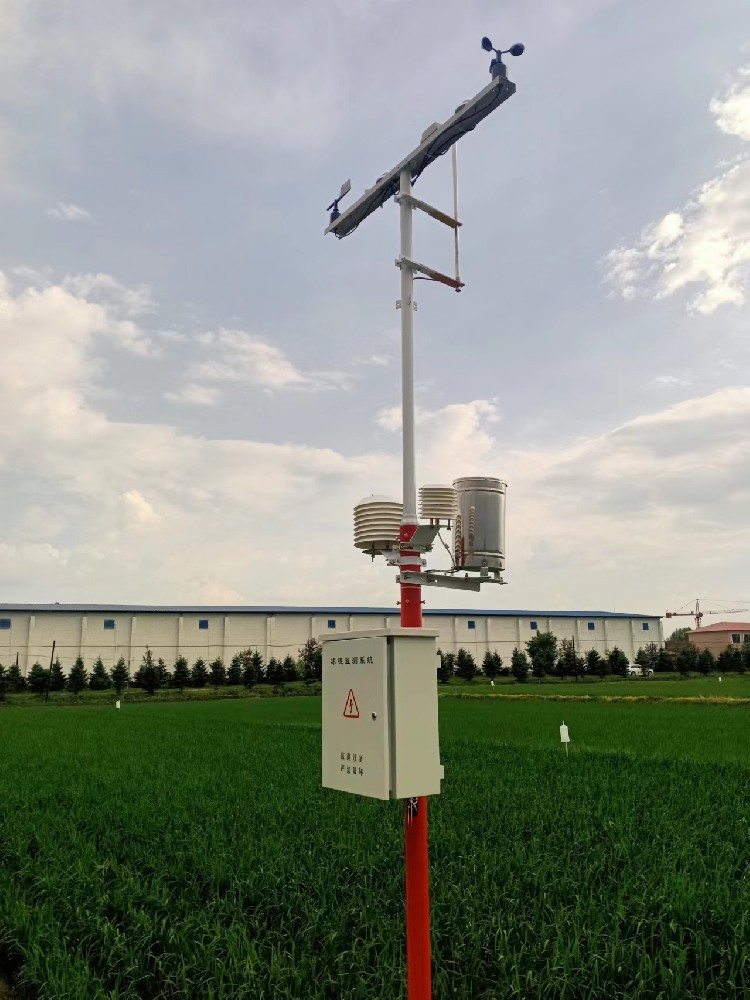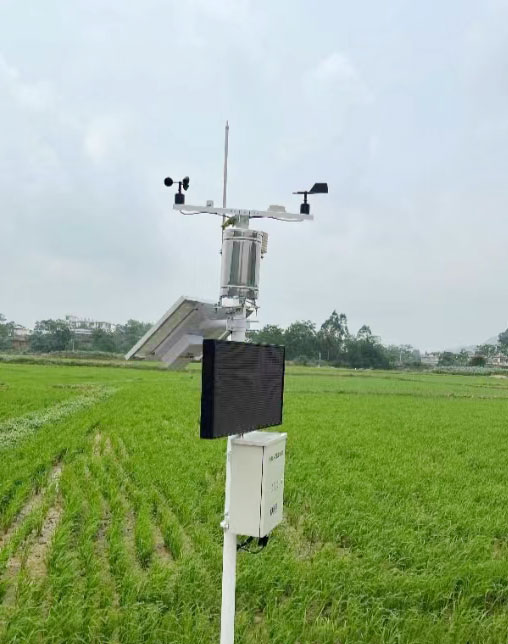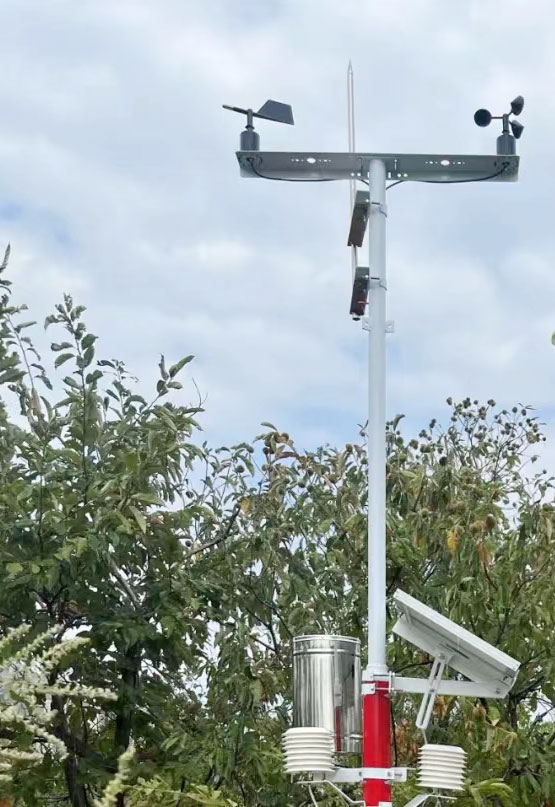

— Blogs —
—Products—
 Consumer hotline +8618073152920
Consumer hotline +8618073152920 WhatsApp:+8615367865107
Address:Room 102, District D, Houhu Industrial Park, Yuelu District, Changsha City, Hunan Province, China
Product knowledge
Time:2024-11-21 14:20:44 Popularity:275
- Rain Gauge: An instrument used to measure the amount of precipitation (such as rain, snow, etc.).
- Weather Station: A facility that observes and records weather phenomena and their related parameters.
- Rain Gauge Weather Station: A system combining the functions of both a rain gauge and a weather station, capable of monitoring and recording precipitation amounts, as well as other weather elements (such as temperature, humidity, wind speed, wind direction, etc.) in real time.
1. Accurate Precipitation Measurement: The rain gauge can precisely measure and record the amount of precipitation over an hour, a day, or specific time intervals.
2. Monitoring Other Weather Elements: Besides precipitation, the station can monitor temperature, humidity, wind speed, wind direction, and other weather variables, offering a comprehensive weather overview.
3. Data Recording and Transmission: It records the collected data and transmits it in real time to data processing centers or environmental monitoring platforms for easy viewing and analysis by users.

1. Rain Gauge:
- Tipping Bucket Rain Gauge: Uses a small bucket that, when a certain amount of water accumulates (typically 0.2mm), tips over and resets.
- Weighing Rain Gauge: Measures the weight of the collected water, providing more precise readings.
- Piezoelectric Rain Gauge: Uses piezoelectric ceramic sensors to detect the impact force of raindrops, allowing it to detect everything from light drizzles to heavy rain with high accuracy. This type of gauge is known for its simple installation, data accuracy, large monitoring range, and ability to precisely measure heavy rain.
2. Temperature and Humidity Sensors: Measure the air temperature and humidity levels, contributing to a more comprehensive understanding of weather conditions.
3. Wind Speed and Direction Sensors: Measure wind speed and direction, assisting in weather pattern analysis.
4. Barometric Pressure Sensors: Measure atmospheric pressure, helping in short-term weather predictions.
5. Data Logger: Records data from the rain gauge and other sensors, typically including temperature, humidity, wind speed, etc.
6. Transmitter: For wireless weather stations, the transmitter sends data from the sensors to the central receiving station or cloud service.
7. Mounting Bracket or Stand: Positions the rain gauge at the appropriate height above the ground for accurate readings.
8. Additional Sensors: Some weather stations include extra sensors for a more complete weather profile, such as light sensors or UV sensors.

1. Collection: The rain gauge collects precipitation, often directing it into a measuring container via a funnel.
2. Measurement: The rain gauge type determines how the precipitation is measured. The tipping bucket counts the number of bucket tips, while the weighing gauge measures the weight of the collected water.
3. Data Recording: The data logger regularly records measurement results, typically every minute or hour.
4. Transmission: If the station is wireless, the data logger sends the collected data to a base station or cloud service.
5. Data Analysis: Collected data can be analyzed to identify local weather patterns, the total precipitation over a period, or to trigger alerts for heavy rainfall.
1. Meteorological Monitoring: Meteorological departments use rain gauge weather stations to monitor and record precipitation data, providing foundational data for weather forecasting and climate studies.
2. Hydrological Monitoring: Hydrological stations utilize rain gauge weather stations to track rainfall, assessing changes in water levels in rivers, lakes, and other water bodies, and gauging flood risks.
3. Agricultural Research: In agriculture, these stations assess the impact of rainfall on crop growth, guiding farming practices and irrigation schedules.
4. Environmental Protection: Environmental agencies use the data from rain gauge weather stations to monitor the effects of precipitation on the environment, such as soil erosion, water runoff, and more.

1. Automatic Rainfall Monitoring Station: Automatically collects ground-level precipitation data and transmits it accurately to an environmental monitoring platform, allowing users to view real-time data and analyze rainfall trends.
2. Tipping Bucket Rain Gauge: A traditional device for measuring rainfall by counting bucket tips.
3. Optical Rain Gauge: Uses optical sensors to detect the number, size, and velocity of raindrops, calculating precipitation from this data.
4. Weighing Rain Gauge: Measures the weight of collected water for more precise measurements.
5. Piezoelectric Rain Gauge: Measures the impact force of raindrops using piezoelectric sensors, able to monitor rain intensity with high accuracy, from light showers to heavy storms.
1. High-Precision Measurement: Utilizes high-accuracy sensors and technologies to ensure reliable and accurate measurements.
2. Automation and Real-Time Data: The system is designed for continuous data collection and processing, with the ability for users to access real-time data through the internet or mobile applications.
3. Long-Term Stability: Built with durable materials and designs that ensure stable performance in various weather conditions.

1. Rain Gauge:
- Primarily measures precipitation, including rainfall and snowfall.
- Common types include siphon, tipping bucket, and optical rain gauges, each measuring precipitation in different ways.
- Typically, a rain gauge provides only precipitation data and cannot measure other weather elements.
2. Rain Gauge Weather Station:
- Measures precipitation as well as other weather variables like temperature, humidity, wind speed, and direction.
- Equipped with multiple sensors, it continuously collects and records a variety of weather data.
- The data collected can support weather forecasting, climate research, and environmental monitoring.
1. Rain Gauge:
- Generally simple in structure, consisting of a water collector, storage container, and other components.
- Rain gauges are compact and lightweight.
2. Rain Gauge Weather Station:
- More complex in design, typically consisting of several sensors, data recorders, transmission devices, and power systems.
- Installed in fixed locations, such as meteorological or hydrological stations, for long-term weather monitoring.
1. Rain Gauge:
- Used in applications where only precipitation data is required, such as irrigation, urban drainage systems, and hydrological monitoring.
- Can be used independently or in combination with other weather instruments for more comprehensive data.
2. Rain Gauge Weather Station:
- Suitable for comprehensive weather monitoring, such as at meteorological stations, environmental monitoring sites, and agricultural research stations.
- Provides multi-dimensional data useful for weather forecasting, climate research, and environmental monitoring.
Pricing of Rain Gauge Weather Stations:
- The price of a rain gauge weather station varies depending on brand, model, features, and accuracy. High-precision, multi-functional stations tend to be more expensive, while basic models with lower accuracy are more affordable. To get specific pricing, it's best to consult manufacturers or sellers.
1. Define Your Needs: Choose a rain gauge weather station based on your specific requirements, such as the type of weather data you need to monitor.
2. Compare Products: Compare different brands and models, considering performance specifications and user reviews.
3. Choose a Reputable Brand: Opt for well-known brands with proven technology and reliable quality assurance.
4. Consider Your Budget: Select a product that fits your budget without compromising on essential features.
5. Data Transmission: Decide if you need a system that can transmit data in real-time via wireless connections.
6. Brand Reputation and Warranty: Choose brands with good reputations for customer support and reliable warranties.
7. Installation and Use: Ensure the rain gauge is easy to install and positioned correctly, avoiding obstructions and ensuring it remains level.
8. Durability and Maintenance: Select rain gauges made from durable, corrosion-resistant materials to ensure reliable outdoor performance. Also, consider how easy it is to clean and maintain, such as the ability to clean the interior of tipping buckets.
9. Sensitivity and Accuracy: Choose models designed to minimize friction and improve measurement accuracy, such as those with dual tipping buckets.
10. Rain Gauge Aperture Size: Ensure the aperture diameter complies with national standards, typically 200mm, to guarantee measurement accuracy.
In summary, a rain gauge weather station is a versatile and high-precision device used for monitoring weather, hydrological conditions, agricultural applications, and environmental protection. When selecting one, it's important to consider your specific needs, as well as factors like performance, pricing, and the reliability of the brand.
Related recommendations
Sensors & Weather Stations Catalog
Agriculture Sensors and Weather Stations Catalog-NiuBoL.pdf
Weather Stations Catalog-NiuBoL.pdf
Related products
 Combined air temperature and relative humidity sensor
Combined air temperature and relative humidity sensor Soil Moisture Temperature sensor for irrigation
Soil Moisture Temperature sensor for irrigation Soil pH sensor RS485 soil Testing instrument soil ph meter for agriculture
Soil pH sensor RS485 soil Testing instrument soil ph meter for agriculture Wind Speed sensor Output Modbus/RS485/Analog/0-5V/4-20mA
Wind Speed sensor Output Modbus/RS485/Analog/0-5V/4-20mA Tipping bucket rain gauge for weather monitoring auto rainfall sensor RS485/Outdoor/stainless steel
Tipping bucket rain gauge for weather monitoring auto rainfall sensor RS485/Outdoor/stainless steel Pyranometer Solar Radiation Sensor 4-20mA/RS485
Pyranometer Solar Radiation Sensor 4-20mA/RS485
Screenshot, WhatsApp to identify the QR code
WhatsApp number:+8615367865107
(Click on WhatsApp to copy and add friends)